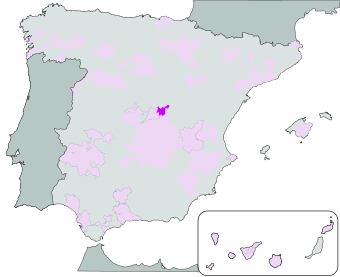Mondéjar (DO) facts for kids
| Wine region | |

Mondéjar DOP in the province of Guadalajara in the region of Castile-La Mancha
|
|
| Official name | D.O.P. Mondéjar |
|---|---|
| Type | Denominación de Origen Protegida (DOP) |
| Year established | 1996 |
| Country | Spain |
| Size of planted vineyards | 446 hectares (1,102 acres) |
| No. of wineries | 2 |
| Wine produced | 1,519 hectolitres |
| Comments | Data for 2016 / 2017 |
Mondéjar is a special area in Spain known for its wines. It has a label called "Denominación de Origen Protegida" (DOP). This means the wines from Mondéjar meet certain quality rules and come from a specific place. This area is in the southeast part of the Province of Guadalajara, in a region called Castile-La Mancha. The main town in this wine region is Mondéjar itself. The DOP covers 19 towns, with Sacedón being another important one.
Contents
History of Mondéjar Wines
People have been making wine in the Mondéjar area for hundreds of years. This was because Mondéjar was on an important road between big cities like Madrid and Valencia. In the past, the wines were mostly sold to people living nearby. Mondéjar wines used to have a different classification called Vinos de la Tierra. But in 1997, they officially became a DOP, which is a higher and more recognized status for wine regions.
Mondéjar's Climate
Even though Mondéjar is in the middle of Spain, it has a climate similar to areas near the Mediterranean Sea. This is because of winds from the east and the area's height above sea level. Summers can get very hot, up to 40°C (104°F). Winters are cold, sometimes dropping to -8°C (18°F). Frost can even happen in April. On average, the area gets about 500 millimeters (20 inches) of rain each year.
Soils for Growing Grapes
The land in the Mondéjar DOP area has gentle, rolling hills. It is next to other wine regions, like Vinos de Madrid to the west and La Mancha to the south. The vineyards are planted quite high up, about 800 meters (2,600 feet) above the sea.
In the southeast, near Mondéjar town, the soil is red. It has a lot of clay and lime, and it's rich in potassium. In the north, near Sacedón, the soil is darker. It's sandy and doesn't have much nitrogen, magnesium, or phosphates. In both areas, the soil deep down is good for water to pass through. It also doesn't have much organic matter.
Grape Varieties Allowed
Only certain types of grapes are allowed to be grown for Mondéjar DOP wines.
- Red Grapes:
- Tempranillo
- Cabernet Sauvignon
- Syrah
- Garnacha
- White Grapes:
- Macabeo
- Malvar
- Sauvignon Blanc
- Torrontés
How Grapes Grow (Viticulture)
The grapevines in Mondéjar start to grow new leaves in the middle of March. Their leaves begin to fall off around the beginning of November. About half of the grapevines in this area are more than 25 years old. Older vines usually produce less fruit, but often with more flavor. Each vine typically produces about 5 to 6 kilograms (11 to 13 pounds) of grapes. The vines are not planted too close together, with about 1,100 vines per hectare (about 445 vines per acre).
See also
 In Spanish: Mondéjar (vino) para niños
In Spanish: Mondéjar (vino) para niños

